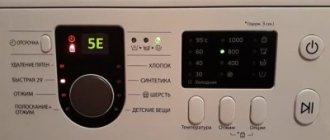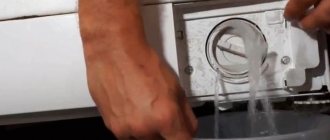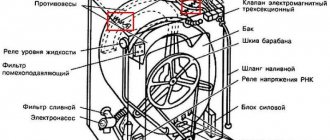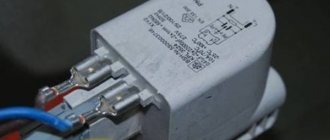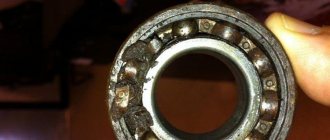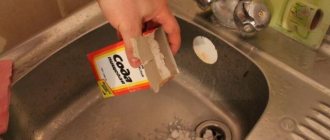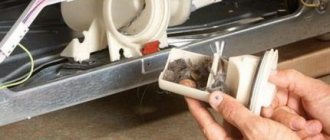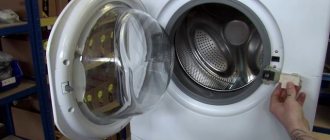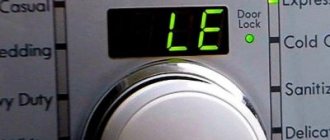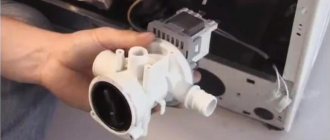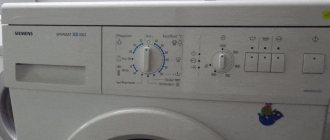Types of filters and their purpose
The normal functioning of the washing machine is ensured by two main and one additional filter:
- mesh filter element of the filler pipe;
The inlet filter is an ordinary metal or polymer mesh with cells of a few tenths of a millimeter, designed to block the path of small particles of plumbing debris into the washing system.
Most often, the inlet mesh element becomes clogged, since it is installed directly at the water inlet into the washing machine.
- drain filter;
The drain filter (main) is a round, oblong plastic plug screwed into a volute designed to protect the drain pump impeller from foreign objects in the form of: toothpicks, matches, buttons and the like.
- water filter for water softening (purchased and installed separately)
The plumbing systems of our apartment buildings leave much to be desired, so the water entering the washing machine may contain pieces of rust, sand and other small particles, the penetration of which into the washing unit is extremely undesirable. Such an abrasive can not only have a negative effect on the mechanical part of the washing machine, but can also lead to damage to things. In addition, rust stains that appear from rust are sometimes completely impossible to wash off.
Cleaning the washing machine filter in different models
The washing machine belongs to the category of complex household appliances. In order for it to work without failures and breakdowns for years, it is necessary to carry out certain preventive maintenance. Cleaning the filters is one of the preventative measures that helps extend the life of the machine. But not every owner of such equipment knows how to clean the filter in a washing machine (LG, Indesit, Samsung and other models).
To protect washing equipment from foreign objects entering it, two filters are installed in it. The first one is at the water inlet into the machine, the second is at the outlet, in front of the pump.
- Filler filter - helps to avoid the ingress of foreign particles and impurities: rust, lime, small debris, dirt. They are often found in tap water, especially if the networks are fairly worn out. If they are not “screened out,” foreign particles will inevitably get into the water supply pipes and become the main cause of blockage.
- The drain filter - its task is to prevent foreign objects that accidentally fall into the laundry drum from entering the machine pump. Foreign debris appears as a result of washing too dirty laundry, woolen items, and fleecy fabrics. Before washing, items remain in the pockets and also settle in the system.
Both filters help to retain elements that are dangerous to the mechanism. As soon as there are too many of them, the filter becomes clogged, water passes through the system more slowly, and the washing time increases. When the blockage reaches a critical level, the equipment will refuse to work altogether. The drum and other parts of the unit will become covered with mucus, and an unpleasant odor will appear in the machine.
Regular cleaning of filter systems will help to avoid such problems. This should be done at least once every 2-4 months - it all depends on the intensity of use of the equipment.
If you often have to wash very dirty things - construction clothes, work uniforms, you should clean the system much more often - at intervals of 1.5-2 months. After washing down pillows, blankets, blankets, the filter is inspected immediately, especially if your tap water is not soft.
During washing, the lint from such linen bunches up into lumps like papier-mâché. If there are too many of them, they will quickly clog the entire drainage system.
Where is the drain filter located?
Before you begin the process of cleaning the drain system, you need to find the filter. Its location depends on the make and model of the car. In most options, manufacturers did not become sophisticated and installed a drain element next to the pump, which is located at the bottom of the washer.
For LG and Candy models, the filter is hidden in the lower left part of the machine. From the outside it is covered with a door or a removable panel. For top-loading washers like Whirlpool, the filter is also located at the bottom left.
For washing machines Indesit, Hotpoint Ariston, Bosch, Siemens, Electrolux, Zanussi, Samsung, Atlant, the drain element is located in the lower right part of the machine. It is covered with a door or decorative panel.
How to clean the drain filter in a washing machine? It's not as difficult as it might seem at first glance. The main thing is to follow the steps.
- Disconnect the equipment from the network. Water is an excellent conductor of electricity. And if your equipment has been serving you for many years, it is possible that the insulation of the wires in it has become thinner, and it can cause electric shock.
- Close the water supply valve. To carry out work, it may be necessary to move the unit to the side. Don't want to accidentally cause a flood? Close the valve.
- Open the door or panel. Don't be afraid to break this element. As a rule, it is held on by rivets, which easily give in with a little effort.
- Prepare a rag and a container for water. There is always a small amount of water in the tank. For convenience, take a flat, wide bowl that can be placed under the machine.
- Drain the water. Some developers have equipped the filter with a small hose. If there is one, unscrew the plug at its end and drain the water into the dish. If there is no hose, place the container as close to the machine as possible and gradually unscrew the cap. Do not forget to place a rag under the machine, this will prevent water from leaking under the unit.
- We clean the filter. Unscrew the lid and take it out. Even if your model has a hose, be prepared that there will still be a small amount of liquid left in the reservoir. Clear the inside of any foreign objects. Do not forget to feel the vacated hole with your fingers; debris could remain inside. Rinse the part from plaque.
- We put the filter in place. Do this evenly, otherwise you will miss the thread and the element will fit crookedly. Return the hose to its original position and cover it with a door or panel.
Not all machines are equipped with this type of filtration. But modern washing machines such as Ariston Hotpoint, Bosch, Siemens, Electrolux, Zanussi, Samsung, Beko, Atlant, Ardo are equipped with them, so every owner of this equipment should know how to clean the filter for incoming water.
The inlet filter is a small round metal mesh that traps small particles found in tap water. Once the amount of plaque becomes too large, water access becomes difficult. It's time to clean the mesh.
We invite you to familiarize yourself with the Tile cleaning product: a review of homemade and specialized
Install the inlet filter on the back of the machine, in the same place where the water supply control valve is located. To clean the water filter, follow the order of work.
- Remove the plug from the network. This will eliminate the possibility of electric shock.
- Close the water supply valve. This must be done. Otherwise, you are guaranteed a flood.
- Disconnect the hose. It screws into the top of the back panel of the washing machine and is not difficult to find. Carefully turn the wheel on the hose. If it is too tight, use an adjustable wrench.
- Clean the filter. There is an inlet filter located immediately under the hose; finding it is not difficult. To get it out, take pliers. Carefully remove all debris to better clean the mesh, take a brush, an old toothbrush will do. Do not use cleaning agents as they may damage the product. You don't need high pressure; moderately hot is fine.
- Installation of the element. We return it to its original position and connect the water supply hose. Don't forget to open the valve.
How to properly clean the filter
Most often, the drain filter can be unscrewed even without much effort, but if it has not been cleaned for many years, it can “stick.” Unscrewing the part will not be so easy. Don't give up, the problem can be solved. Get ready to remove the entire structure along with the pump.
To get to the filter element, you will need to lay the car on its side. Models such as LG, Samsung, Whirlpool, Candy, Indesit and Hotpoint Ariston have a removable bottom. For Bosch and Siemens, the front panel can be easily removed. In the case of Electrolux, you need to remove the back wall.
Unscrew the screws holding the drain device and carefully unscrew the filter from the inside. If this fails, get ready to disassemble the entire structure into individual elements. It is more convenient to do this on the table. Once the part is removed, remove any dirt from it and rinse it. Reassemble everything in reverse order and install the system in place.
It happens that after cleaning, the filter begins to let water through. As a result, a puddle forms on the floor under the machine. There are several reasons for this phenomenon:
- The filter is not level or the cap is not tightened completely. Unscrew the cover and try to install it again. The thread should go straight without distortion. There is no need to tighten the cap too much - the plastic part can easily be damaged or twisted.
- Gasket defect. The gasket ensures a tight fit of the lid to the opening of the machine. During operation, it may become unusable due to drying out or careless use. To eliminate the leak, you will need to replace this product. If the rubber band is not sold individually, the entire filter element will have to be replaced.
- Damage to thread or filter. The thread on the lid is plastic and can be easily damaged if handled carelessly. It is enough to apply too much force when unscrewing or tightening the lid. The threads can be damaged if the cover is installed unevenly. In both options, the contact of the lid with the threads of the machine becomes less tight, and water begins to ooze out. The situation can be corrected by replacing the cover paired with the snail.
How to install a filter in an automatic car
Care Tips
- Regular cleaning of the washing machine filter. Clean both filters at least once every 3-4 months. If your automatic washing machine works in heavy duty mode, do not be lazy to carry out this procedure at least once every couple of months.
- Do not leave items in the drum after washing. When the machine is closed in a humid environment, mold and mildew actively multiply. All this does not have the best effect on the condition of the filter.
- The machine began to spend more time on the same modes: water takes a long time to fill and drains for a long time - a clear sign of clogged filters. It's time to clean them, this will not only improve the condition of the machine and the quality of the wash, but also save energy.
- Use proven laundry detergents. A low-quality product will accelerate the wear of important parts and lead to equipment failure. If you notice that the powder does not dissolve well in water and forms balls, replace it with another product.
- Check the pockets of items before washing. Most often, foreign objects get into the drum from pockets. This will protect not only the filter, but also other elements of the machine from serious damage.
Share
Cool
Share
Where are the drain and fill filters located?
The location of the filters for most household washing units is the same. The filling filter element is installed in the rear (top) part of the washing unit, directly on the inlet fitting of the water supply valve.
The drain filter must be looked for at the lowest point of the washing machine; it is there that the water can be drained by gravity in the event of an emergency. Most often, access to it is closed by a special hatch or decorative panel; for ease of maintenance, it is located in the front part of the machine. In the same place there may be a small-diameter emergency drain pipe with a plug at the end in the form of a plug. This tube is designed for emergency drainage of water from the washing machine tank.
Features of the location of the drain filter from different manufacturers
The main criterion that manufacturers follow when installing a drain filter is easy access to it for maintenance. It can be located on the front (most models) or side (for example Samsung) side. Typically, the pipe into which the filter element is screwed is made together with the drain pump body; when the pump is removed, the element itself is accordingly removed. In order to get to it, you must either remove the decorative trim, or open or slide a special door.
Procedure
The principles for accessing and cleaning the drain pump filter vary depending on the brand of washing machine. These nuances must be taken into account to avoid accidental breakdown of the device.
LG
The drain filter for this brand of washing machines is located at the bottom of the body, in the left corner.
Due to its location, it may not always be covered with a decorative panel; if the pump is located too close to the floor, its cover can be seen on the front of the machine.
To clean the mesh, the element must be removed by twisting it out. Upon completion of the procedure, screw the part back and, if necessary, return the panel to its place.
Bosch
The catcher is located on the front side of the device of this brand and can be covered either with a separate cover or with a wide front panel. Before removing the part, it will have to be completely dismantled; it is secured using small latches on the body.
The filter is removed by twisting it out; there are no special features for this procedure for a specific model.
Additionally, you should wipe the inside of the decorative panel; it also often gets dirty.
Zanussi
The drain pump filter is closed by a hinged hatch, which can be rectangular or round. It is always located in the lower right corner of the washing machine. To remove the element with the catcher, it must be unscrewed without using force.
Samsung
The process of removing the drain filter mesh looks standard and does not differ from other models. The element itself is located in the lower right corner of the device, behind a small hatch.
For ease of turning, there is a small handle on its base.
Indesit
To remove the required part from the body of a washing machine of this brand, you will need a small flat-head screwdriver. With its help, you need to pry off the front panel located in the lower right corner of the front part. A standard twist-out filter is hidden behind the panel.
How to remove and clean the drain filter
If it turns out that after spinning the clothes are very wet, and the washing cycle itself lasts longer than the allotted time, then the problem may be that the drain pump is blocked. The cause could be anything from a torn button from a garment to an underwire from a bra. To unlock the pump, you must first remove the drain filter. It is at the location of the drain filter element that all the debris collects.
Before unscrewing the part, it is worth preparing a container for water and a rag. If the washing machine was in operation, there will definitely be a small amount of water in the drain system. If the filter has to be cleaned in emergency mode, when the water has not drained from the washing tank, then a larger container for collecting water must be taken.
Having placed a towel and placed a container under the drain hole, you can begin to unscrew. Under normal conditions, the filter should unscrew freely counterclockwise after a little effort. By pulling it towards you, it is necessary to remove foreign objects and remaining contaminants from it.
Be sure to look into the drain hole and assess the condition of the drain pump impeller!
If objects get into a running pump, it can be damaged, and pieces of flying plastic can block the operation of the entire pump. If there are no items, the part can be put back.
Before installation, it would be a good idea to check the condition of the rubber gasket on the filter housing. After 3-5 years of operation, the rubber becomes rough and cracks under the influence of temperature and detergents. This may lead to unwanted leakage. It is twisted clockwise until it stops, with little effort.
Do not unscrew or tighten the drain filter with pliers, as you can break its internal parts and damage the threads. All these procedures are performed by hand!
How to clean a washing machine filter at home
For complex household appliances, which includes a washing machine, preventive maintenance is necessary. Otherwise, active use will quickly damage the machine.
One type of regular equipment maintenance is cleaning the washing machine filter. It is needed for the normal operation of the drain pump. The filter serves as a barrier that protects the pump from foreign objects entering the tank, lint from fabrics, wool, hair and other debris. A clogged filter makes it difficult to pump water out of the tank and can cause pump failure.
Therefore, we have prepared an instructional article about cleaning the filter and the main problems that washing machine owners encounter during cleaning.
First, let's figure out where to look for the node we need. Everyone's cars are different, both in brand and model. They also differ in the type of laundry loading. But with all the variety of types of equipment, its manufacturers install filters at the bottom of the washing machine next to the pump.
Since this is an internal part of the machine, it is closed from the outside with a hatch or removable panel.
To make it easier for you to understand your washing machine, we have put together a photo table with the location of the filter for the main brands of SMA.
| For LG washing machines, the pump filter is located at the bottom left behind the hatch. |
| For machines of the Indesit and Ariston brands, look for the filter behind the lower removable panel on the right. |
| For Candy washing machines, the drain filter is located on the left side behind the hatch. |
| For Bosch and Siemens cars, the unit is located on the right behind the hatch or decorative strip. |
| In the Electrolux or Zanussi brands, the filter is located at the bottom right and covered with a plastic hatch. |
| In Samsung washing machines, look for the filter in the lower right corner behind the plastic panel or behind the hatch. |
| On top-loading washers, such as the Whirlpool, the part is located at the bottom left. |
| In the Atlant washing machine, the filter is hidden behind the hatch at the bottom right. |
We will clean the trap filter step by step, as our service technicians do.
1. For safety, turn off the water supply and disconnect the machine from the network. You may have to lift the equipment or move it from its place. Agree that you don’t want to flood the floor with water or get an electric shock while working.
2. Find where the filter is on the washing machine and open the hatch cover, or remove the false panel from the bottom of the body. The hatch is usually fixed with a latch, and the lid is held tightly. Use a flathead screwdriver or a flat-edged cutlery knife to pry the lid open. In some models, the lid can be easily opened by hand.
The false panel is held on by latches or hooks and can be removed in two ways:
- moving towards you (sometimes you first need to pry off the top of the panel with a screwdriver)
- sideways, usually from right to left.
3. Prepare a rag and drain the remaining water from the washing machine. The water in the car is completely pumped out only from the tank. There is always some water left in the drain system, of which the filter is part. It will spill out when you unscrew the filter. Therefore, to avoid flooding the floor, place a rag under the machine or lift the body and place a flat basin or other container.
Even if you used the emergency hose, a little liquid will still remain in the washing machine.
To drain it completely, carefully turn the drain filter plug 45-60 degrees counterclockwise and let the remaining water drain into a nearby container or onto a rag.
If the plug is additionally secured with a special screw, as, for example, in Candy Holiday 181 machines, then first loosen or unscrew it using a screwdriver.
4. Completely unscrew and pull out the filter.
5. Clean and rinse the filter. First, we take out large debris - wool, threads, foreign objects. Then we take a regular dish sponge with an abrasive layer and clean the surface of plaque. Then rinse the filter thoroughly under running warm water.
Be sure to check the hole in the machine and clean it of any remaining debris. At the same time, wipe off dirt and plaque with a damp cloth or sponge.
6. Check the drain pump. Don’t forget to look into the drain pump, there may also be dirt left there. Shine a flashlight into the hole and remove any debris that has slipped into the pump. To check, rotate the impeller; nothing should interfere with its rotation.
7. Put the filter in place. We insert it into the hole evenly, without distortions and tightly, but carefully. Tighten the filter plug clockwise. We screw in the fixing bolt, if there was one (for example, in Candy Holiday 181). In some models of AEG, LG, Electrolux, Zanussi, you must first insert the filter into the slot and then screw on the locking cover.
8.Plug in the machine and check for leaks. To avoid flooding the floor during washing, we check the equipment for water leakage from the filter. We put on a test rinse and see if there are any drops or streams from under the filter cover. If everything is dry, close the hatch or replace the false panel and the washing machine itself.
Information on how to properly clean the drain filter in your washing machine model is in the user manual. If you forget where it is, use our database of instructions for washing machines. For cleaning information, see the “Cleaning and Maintaining Your Washing Machine” section of the manual.
Manufacturers recommend cleaning the filter every 2 to 4 months. Focus on the frequency of washing. That is, the more often we use the machine, the more often we clean the filter. For example, when using a machine daily in a large family with children, it is better to clean the filter once a month.
We suggest you familiarize yourself with Checking and replacing the pressure switch in a dishwasher
In addition, based on experience in servicing washing machines, it should be noted that the frequency of cleaning the drainage trap also depends on the type of fabric. For example, in winter, woolen and pile fabrics are washed more often: flannel, flannel. They produce a lot of tissue substrate in the form of lint, which clogs the filter. Therefore, the trap should be cleaned more often.
If you are washing something completely trashy, for example, a feather pillow or a down jacket made with natural down, then we recommend cleaning the filter immediately after washing.
A dirty trap filter creates serious problems over time:
- Unpleasant odor from the machine and washed clothes. Debris and dirt stuck in the filter are an excellent breeding ground for germs. The dirty lump begins to sour and smell bad. The smell can penetrate into the tank, and after washing the laundry, instead of a pure aroma, receives a very unpleasant aroma.
- Bad drain. A clog in the washing machine filter prevents normal draining. If the debris is not removed in time, the filter may become so clogged that the washing machine will completely stop draining water from the tank.
- Pump failure or breakdown. There is a possibility that a foreign body may slip from the filter into the pump. This can cause the pump to jam and stop pumping water. In some cases, metal objects break the impeller blades or damage the pump body. As a result, repair or complete replacement of the pump will be required.
Sometimes cleaning the washing machine pump filter is difficult because it is impossible to get it out of the machine:
- you try to turn the handle to no avail;
- or the filter is stuck in the hole and cannot be pulled out.
Such situations occur if the drainage unit has not been cleaned for a long time.
The filter may not unscrew for two reasons. Firstly, a foreign object (for example, a piece of bra wire) can prevent rotation, and secondly, scale formed on the threads and gasket.
Most often, pulling out the filter is prevented by a foreign object stuck across it or a lint ball of debris inside.
If you find yourself in this situation, you can act in two ways:
- Use pliers if the filter does not unscrew. Try using them to turn the filter knob. Do this very carefully, without fanaticism, so as not to break the part.
- Clean the filter through the removed pump if pliers do not help to unscrew it or the filter cannot be pulled out. Depending on the make and model of the machine, you will need to remove the back or front wall of the machine body, disconnect the wiring, remove the clamps that secure the drain pipe and hose to the pump volute, and pull out the pump itself with the volute. Next, it is most convenient to clean the filter through the hole for the drain pipe. Or disconnect the pump from the volute (it is secured with screws or latches) and clean the filter through the pump hole. After this, it should easily unscrew and pull out.
For those who nevertheless decided to deal with the stuck unit on their own, we recommend the article “How to get the drain filter if it cannot be unscrewed.”
It happens that when checking for leaks after cleaning the filter, it leaks. Or water begins to seep in after one or two washes. There are 3 reasons for the leak:
- The filter is inserted unevenly or is loosely screwed in. The part must be inserted straight to avoid movement along the thread. And also tighten it more tightly, fixing the filter. But this must be done carefully. Plastic threads can be easily stripped if you press too hard. If there is a leak, unscrew the filter, insert it straight and tighten it again. Do not forget to place a rag or a container to collect water before removing it.
- Gasket defect. Tight contact of the filter with the socket is ensured by a rubber gasket, as in taps or hoses. It may dry out over time or become damaged if you remove the filter carelessly or clean it with a sharp tool. To eliminate a leak, you need to change the gasket, when possible, or the entire filter, if sealing rubber bands are not sold separately.
- Damage to thread or filter. The filter or the walls of the cochlea are damaged if the part is removed or unscrewed by force. The thread on the snail filter or glass can be torn off if you tighten the plug with significant force. In both cases, the contact becomes not tight enough to hold water. Replacing the filter or the “volute and filter” pair helps to get rid of leaks in such situations. If you can’t handle it yourself, call a professional.
The RemBytTech service department quickly services washing machines at home. Are you poorly versed in technology, don’t have time to study the manual and tinker with the machine yourself, or can’t unscrew the filter? Contact us! The technician will clean the drain filter of a washing machine of any brand and, if necessary, replace it.
How to remove and clean the fill filter
Almost all modern units are equipped with a mesh fill filter. To gain access to it, you need to disconnect the inlet hose from the washing machine, first turning off the water supply tap.
To equalize the pressure, it is best to wait a few minutes and only then unscrew the hose nut.
Before unscrewing the hose, it is necessary to place a small cloth under the fitting so that residual water does not fall on the back wall of the machine or the floor. Using pliers, grab the filter by the protruding part and pull it towards you. After removal, you need to inspect the mesh for dirt, and if necessary, clean it under running water using an old toothbrush.
A clogged inlet filter can be judged by a small pressure or no water flow at all; when you start washing, powder is poured into the tray. In addition, there are washing units equipped with indicators warning of filter clogging.
What to do if the drain filter cannot be removed
If you cannot unscrew the drain filter with normal force, then it is better to disassemble the entire pump unit. The reason for its blockage can also be an object that has fallen into its cavity, and without removing the pump, it will not be possible to remove it from there. To troubleshoot the problem you must:
- Disconnect the washing machine from the power supply and water supply;
- Remove protective decorative elements and provide access to the drain pump housing;
- Unscrew all the bolts, nuts and screws that secure the drain pipe and pump to the body of the washing unit;
- Loosen and push back the clamps securing the drain pipe and drain hose to the pump body;
- Remove the pipe and hose;
- Inspect the filter cavity through the pipes, and if there are foreign objects, remove them.
In order to remove a stuck object, sometimes it is enough to simply shake the pump, and the button or paper clip stuck there will fall out through the hole in the nozzle. Otherwise, you can use a screwdriver or tweezers.
Why can’t I unscrew and remove the filter?
The main enemy of all mechanical parts of a washing machine is water with detergents and salts dissolved in it. During operation, under the influence of temperature, these substances are deposited on the walls of all elements involved in the washing process. This, in turn, disrupts their work. If the filter elements have not been unscrewed for a long time, salts deposited on the threads of the filter housing and drain pipe can cause them to block. The part may also not unscrew if there is a foreign object between its body and the impeller.
All the ways to open and remove the drain filter
To remove the drain filter from the drain pipe, sometimes you can do without removing the pump. If the filter can be unscrewed at least half a turn, you should try to unscrew it “back and forth” with gentle movements. If the body is blocked by scale, then it is destroyed, and then this method works. If some “trifle” gets in the way, its position in the body may change and the part can be unscrewed.
Maintenance frequency
Standard recommendations suggest cleaning the washing machine filter once every 2-4 months, depending on the intensity of its use.
If the device is used several times daily, the drain pump mesh should be cleaned every month or more often.
Also, the frequency of maintenance of this part depends on the type of fabrics that are most often washed. For example, if you frequently load flannel, flannel, or woolen items into the tank, it is recommended to clean the filter once every few weeks.
If a down jacket or feather pillow has been washed, then it is necessary to remove dirt from the filter immediately after the end of the cycle. If you find a missing part on clothing after washing (a bra wire or a button), you should immediately check the drain filter mesh.
What to do if the filter is leaking
If a puddle of water has formed at the bottom of the machine, there may be three reasons for the leak:
- violation of the integrity of the gasket;
- crack in the pump drain pipe;
- crack in the filter cover.
If the gasket becomes unusable, it is replaced with a new one. If a crack forms in the cover, you should buy a new one and install it in place. A crack in the body of the pump drain pipe leads to either replacing the pipe or replacing the entire pump if it has a non-demountable body.
When carrying out all maintenance work on the washing machine, and even more so when carrying out repairs, it is always necessary to disconnect it from the power supply.
In the case of servicing the filler filter, at a minimum, turn off the water supply valve. Keeping the filters clean is the key to trouble-free operation of the washing unit for many years.
